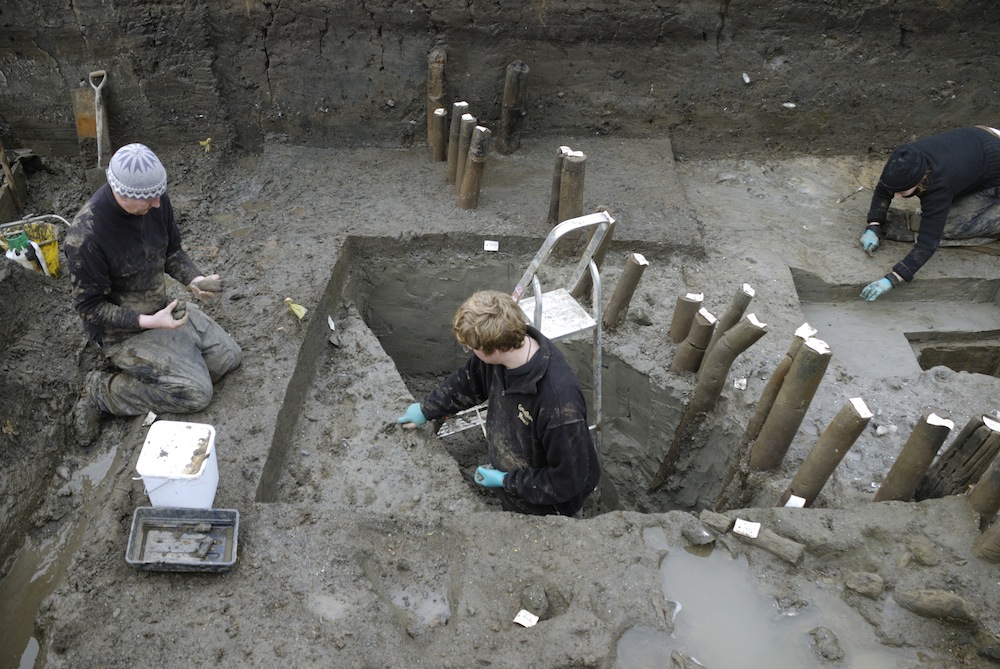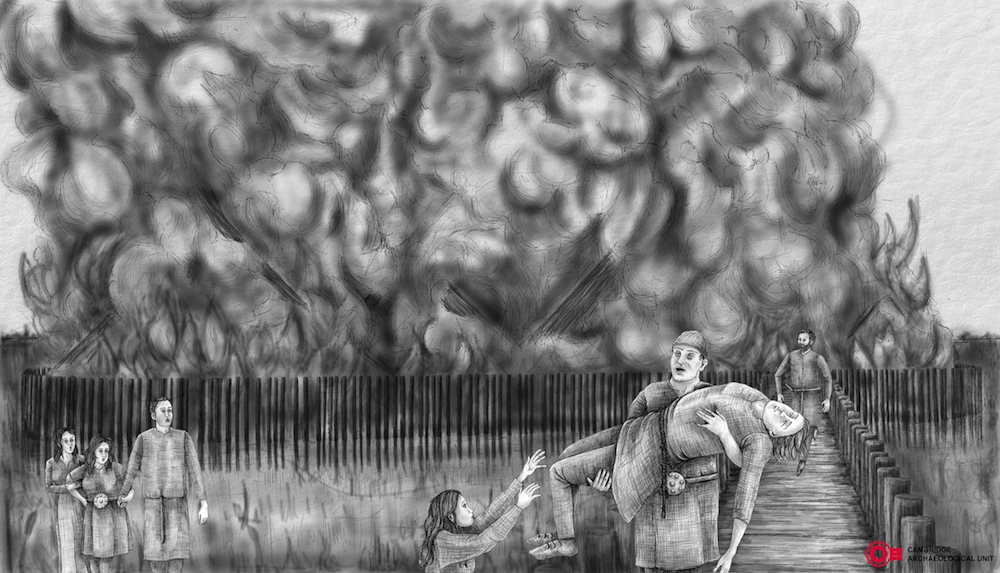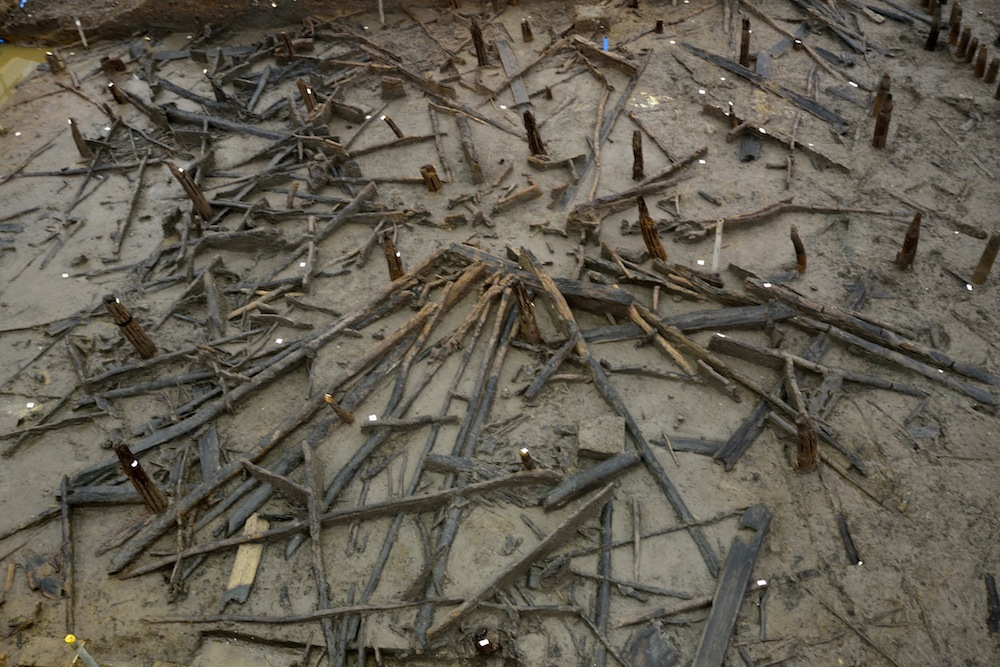Prehistoric Village Likely Torched by Bronze-Age Warriors

A fire that destroyed a Bronze Age village in the marshlands of eastern England around 3,000 years ago may have been set on purpose, possibly in a raid by warriors from a hostile group, according to a new archaeological study.
"We've been working with [a fire] investigator who works a lot with modern fires, and he thinks there's a good chance that the fire was set deliberately," said Selina Davenport, an archaeologist at the University of Cambridge.
The researchers found four houses that were likely all burned at the same time, which suggests it was a large fire, they said. [See Photos of the Must Farm Site and Its Bronze-Age Treasures]
"For that to have spread from something like a spark off a hearth is unlikely," Davenport told Live Science. "These people were really good at living in wooden houses, so I donꞌt think they were just catching fire accidently very often."

The original Bronze Age village at the Must Farm archaeological site in Peterboroughconsisted of up to eight circular wooden houses built on stilts above a river, and would have been home to several families, archaeologists said.
Tree-ring analysis dated the posts from the houses to between 1290 and 1250 B.C., and showed they were all cut down in a single autumn, according to the researchers. A wooden wall, or palisade, near the houses was built at the same time, which the archaeologists think may be a sign that the villagers were living in hostile territory.
But within a few years of being built, the prehistoric village was burned down and abandoned. It seems no effort was made to resettle the village, the researchers said, or to recover the many items that the villagers left behind in their hurry to escape, which included wooden boats, weapons, stone and metal tools, patterned sets of kitchen pottery, jewelry made from imported glass and amber beads, and clothes of finely woven fabrics.
Sign up for the Live Science daily newsletter now
Get the world’s most fascinating discoveries delivered straight to your inbox.
The abundance of artifacts found by the Cambridge Archeological Unit during a 10-month excavation at the Must Farm site has inspired the village's comparison with the Roman city of Pompeii, which was destroyed and preserved in ash when the nearby volcano Vesuvius erupted in A.D. 79.
"The analogy comes from the idea that there is one moment in time that has been captured by a destructive event," Davenport said. "At Pompeii, that's the destruction by the volcano, and here we have this fire that just rips through the settlement, and the settlement collapses and is perfectly preserved in the silt."
Bronze Age sophisticates
As at Pompeii, the disaster in the Bronze Age village has provided modern archaeologists with a wealth of information about the remarkably sophisticated people who lived there a little more than 3,000 years ago. [The 7 Most Mysterious Archaeological Finds on Earth]
The discoveries include many rare wooden tools and other artifacts preserved in the marshy ground of the fenlands, such as kitchen platters made from sewn layers of bark; wooden spoons and buckets; a bronze ax and a bronze-tipped spear with their wooden hafts intact; eight log boats; and one of the oldest wooden wheels ever found in Britain.
Other finds include a matching set of kitchen pots, from very small bowls to tall storage jars, which appear to have been made by a single potter from local clay. The researchers also found the charred remains of several different woven fabrics, mainly of linen spun from flax plants, which were probably used for clothing and other purposes, such as traps and binding materials.
Davenport supervised visits to the site by more than 2,000 members of the public during the recent excavations, including visits by schools and archaeological interest groups.
"Non-archeologists who come here imagine that life 3,000 years ago was very simple, and the thing they're really excited about is the wealth of material culture, its sophistication, and how varied it all is," she said.

Several items originated overseas, indicating the extent of international trade in the 1200s B.C., Davenport added.
"We've got evidence of trade with the continent in some of our metalwork, but we've also got blue glass beads coming from Syria or Turkey, and amber beads probably coming from the Baltic," she said.
It's not known what the villagers traded in return, but since they lived on a river, they may have traded in fish, which were an important food resource for the village, according to Davenport. The excavations also revealed that the villagers hunted deer and wild boar, grew crops of wheat and barley, and herded sheep and cattle, she added.
Skull and bones
A single human skull was found at the site, but the archeologists think it was probably a "curated item" kept in one of the houses — a practice that was not uncommon in prehistoric Britain, Davenport said. [8 Grisly Archaeological Discoveries]
The complete skeletons of two dogs were also found. "They were the only animals we believe were actually living on the site with the people, and they seem to have been the only casualties of the fire," she said.
Pieces of wood from the buried Bronze Age village at Must Farm were first uncovered in the 1960s by workmen quarrying for clay. But it was not recognized as an archeological site until the late 1990s, by which time up to half the buried village had been destroyed by quarrying, Davenport said.
Now that the excavation is coming to an end, the site will be backfilled and returned to its commercial owners, who have undertaken not to quarry there.
But researchers will continue to analyze the artifacts that were found at the Must Farm site.
"Even off-site we can continue analyzing it, we can continue studying it, and trying to figure out what was going on," Davenport said. "So, we'll be able to get a lot of information about life in the Bronze Age from our site, and we wouldn't be able to do that if it was still in the ground."
Original article on Live Science.
Tom Metcalfe is a freelance journalist and regular Live Science contributor who is based in London in the United Kingdom. Tom writes mainly about science, space, archaeology, the Earth and the oceans. He has also written for the BBC, NBC News, National Geographic, Scientific American, Air & Space, and many others.











